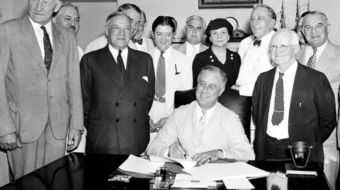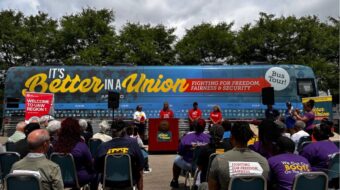President Barack Obama said March 30 that the government will withhold additional long-term federal loans for General Motors and Chrysler unless the company, its creditors and the unions make more concessions. He also raised the possibility of “controlled bankruptcy” for one or both of the two companies.
Hoping to reassure potential car customers, the president announced that the federal government would immediately back the warranties that new car buyers receive – a move he hopes will assure people it is safe to buy American automobiles despite the sorry shape of the industry.
In a statement from the White House, Obama said he is “absolutely committed to the survival of a domestic auto industry that can compete internationally. And yet, our auto industry is not moving in the right direction fast enough.”
Obama’s remarks underlined the extent to which the government is now calling the shots for the two auto giants after recent moves that gave it controlling interest in banks, AIG, Fannie Mae and Freddie Mac.
In an unprecedented move, the administration forced the departure of Rick Wagoner as CEO of General Motors over the weekend.
Ford Motor Co. has not requested federal bailout loans, and was not included in what the president had to say.
The Bush administration, last year, approved $17 billion in federal funds to help GM and Chrysler survive. It also demanded both companies submit restructuring plans that the Obama administration would review. Although he called their efforts “unsatisfactory,” the president offered General Motors “adequate working capital” over the next 60 days to produce a reorganization plan acceptable to the administration.
Obama said Chrysler’s situation is more precarious, and the government will give the company 30 days to sell itself to Fiat, the Italian automaker. “If they are successful, we will consider lending up to $6 billion to help their plan succeed,” the president said.
The Obama move came after an explosion of public outrage over bonuses paid to business executives and AIG executives while the economy tanked. Critics of the president are saying that dumping Wagoner lets the administration deflect attention away from Wall Street where the Treasury Dept. is still up to its neck as it struggles for solutions to the mess there. The administration’s detractors say the moves in Detroit allow Obama to portray himself as tough on the corporate executives who are ruining America, without having to draw blood from the bankers.
Defenders of the administration note that Obama has yet to give AIG one cent. The TARP bailout happened under President Bush. If additional funds are given to AIG or any other banks with no guarantees in exchange, they say, then they might be willing to point the finger.
There is a way forward for the auto industry right now. Beyond turning out “green” cars and a variety of other fuel-efficient vehicles, the industry should re-tool to help meet the enormous mass transit needs of the country. Hopefully, this is the direction in which the Obama administration wants to move.
Unfortunately, “restructuring” has usually meant shutting down production in the U.S., laying off workers and squeezing those remaining for more concessions. The auto workers resent being called on again to be the fall guys. They resent being told that corruption and greed on Wall Street and incompetence in Detroit’s corporate boardrooms can only be solved by busting them and their union.
They particularly resent this because, for decades now, they have been the ones who always lose. The slow drain of the auto industry has drained them of their benefits, wages and jobs.
In his speech Obama announced the appointment of a new “director of recovery for the auto community and workers.”
What will determine the success of any plan for the auto industry is not whether GM or Chrysler survive as profitable outfits. More than keeping any particular company operating, it is the responsibility of government to keep workers of the auto industry employed. “Retraining,” by itself, is meaningless to a worker who asks, “Retraining for what?”
The people of Michigan need a lot more than “training” and tax breaks.
They need a program that involves major government subsidies for new industries to locate in hard-hit areas like Michigan.
The new employers will have to be required to hire the union members who lost their jobs and to pay union wages to the additional workers hired. The Employee Free Choice Act would help a lot in this area.
A massive effort to enlist the universities in establishment of training centers for workers who need new high-tech skills, might not be a bad idea.
A massive plan to create government jobs in the area will be needed. These can include jobs resulting from a new national healthcare plan, for example, or jobs connected with the rebuilding of mass transit,infrastructure or numerous other areas.
In cases where nothing can realistically be done for individuals or for groups of workers, the government plan should incorporate meaningful help in relocating people.
The auto workers were left out of the auto company deliberations when those companies devised their restructuring plans.
The auto workers were left out of the deliberations of the experts who advised the Obama administration about the positions it should take.
The auto workers have been left out of all the bailouts and rescue plans.
The time for leaving them out is over.
jwojcik @ pww.org









